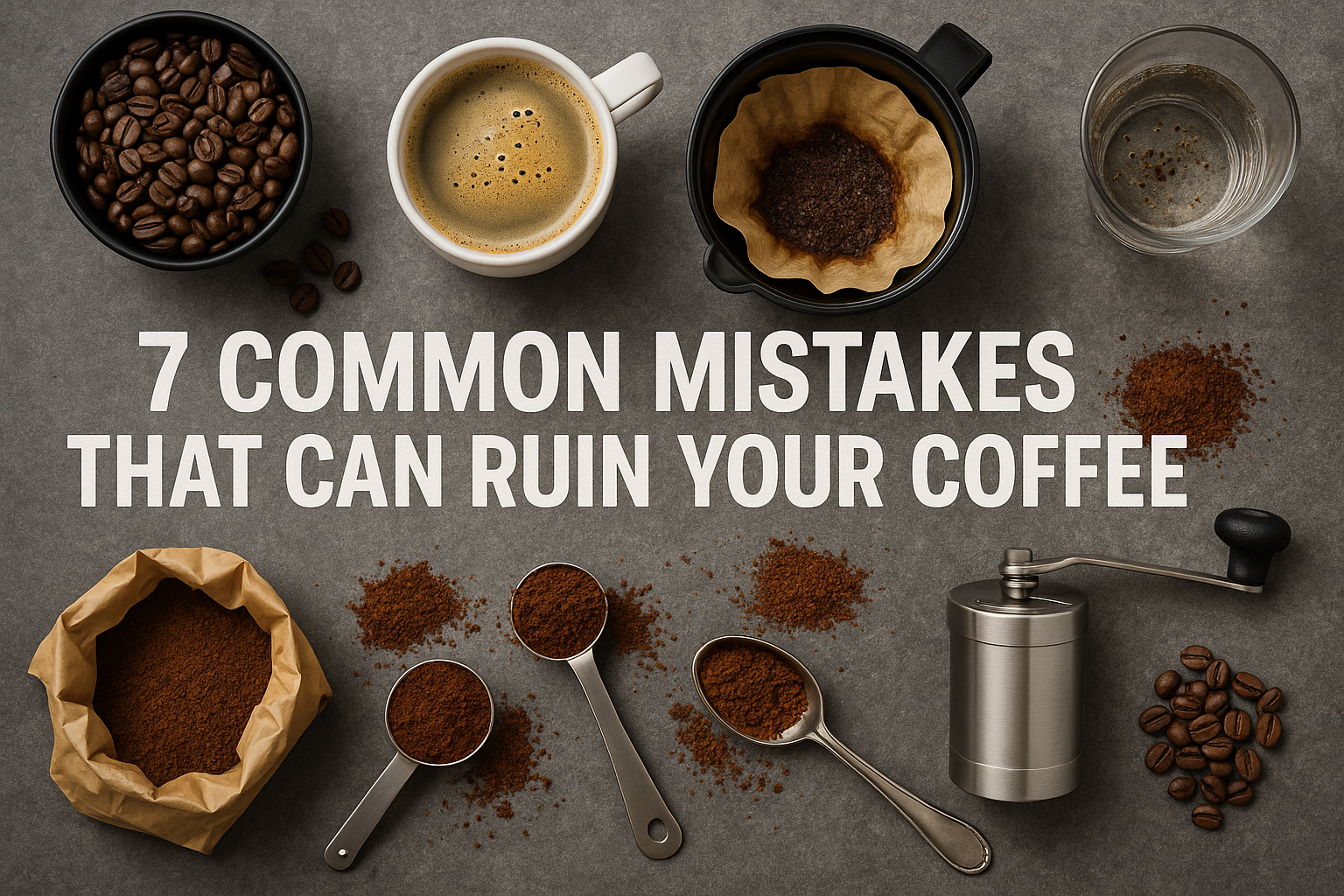Brewing coffee may seem simple—you just add water to ground coffee and let it steep or drip. But if you’ve ever been disappointed by a bitter, weak, or lifeless cup, you know that a lot can go wrong in the process.
The truth is, great coffee depends on a combination of small but crucial details, and making even one mistake can throw off the flavor.
Whether you’re new to coffee brewing or you’ve been making it for years, avoiding these seven common mistakes will help you consistently brew a cup that’s rich, balanced, and full of flavor.
1. Using Stale Coffee Beans
Freshness is one of the most overlooked factors in coffee quality. Coffee beans start losing flavor within two to three weeks of roasting.
Once ground, they lose freshness even faster—sometimes in a matter of hours—because more surface area is exposed to oxygen.
How to avoid this mistake:
- Buy coffee in small amounts to finish within two weeks.
- Look for a roast date on the package, not just an expiration date.
- Store coffee in an airtight container away from heat, light, and moisture.
Pro tip: If possible, grind your coffee right before brewing to preserve its natural aroma and oils.
2. Using the Wrong Grind Size
Grind size directly affects extraction—the process of pulling flavors from the coffee grounds. If the grind is too fine, your coffee can turn bitter and harsh; too coarse, and it can taste weak and underwhelming.
How to avoid this mistake:
- Match grind size to your brewing method:
- French press: Coarse grind
- Pour-over: Medium grind
- Espresso: Fine grind
- Use a burr grinder instead of a blade grinder for a more consistent grind.
Pro tip: If your coffee tastes sour, try grinding finer. If it tastes bitter, try a coarser grind.
3. Ignoring the Coffee-to-Water Ratio
Many home brewers simply scoop coffee grounds by eye, but the right coffee-to-water ratio is essential for balance. Too much coffee will make it overpowering, while too little will make it taste flat.
How to avoid this mistake:
- Use the golden ratio: about 1 to 2 tablespoons of coffee per 6 ounces of water, or a 1:15 to 1:17 ratio by weight.
- Use a kitchen scale for precision, especially if you want consistent results every time.
Pro tip: Adjust the ratio slightly based on personal preference, but always measure for accuracy.
4. Brewing with Poor-Quality Water
Since coffee is about 98% water, its quality can make or break your brew. Tap water with heavy chlorine or odd mineral content can give your coffee an unpleasant taste.
How to avoid this mistake:
- Use filtered water or bottled spring water.
- Aim for a water temperature between 195°F and 205°F (90°C–96°C). Too hot can cause bitterness, too cool can make it sour.
Pro tip: A gooseneck kettle with a thermometer is great for precise water temperature control.
5. Skipping the Bloom
If you’re brewing with fresh coffee and a pour-over or French press method, you might notice bubbles forming when you first pour water over the grounds.
This is the bloom, where carbon dioxide escapes from the coffee. Skipping this step can lead to uneven extraction and muted flavors.
How to avoid this mistake:
- Pour just enough hot water to wet the grounds evenly.
- Let the coffee sit for 30–45 seconds before continuing with the brew.
Pro tip: Blooming works best with coffee that’s been roasted within the last few weeks.
6. Leaving Coffee on the Heat Too Long
Leaving brewed coffee on a hot plate for extended periods can cause it to taste burnt or overly bitter. This is common with drip coffee makers in offices or busy kitchens.
How to avoid this mistake:
- Brew smaller amounts more often instead of making a big batch that sits for hours.
- If you need to keep coffee warm, use a thermal carafe instead of direct heat.
Pro tip: If you make extra coffee, cool it quickly and store it in the fridge for iced coffee later.
7. Neglecting to Clean Your Equipment
Coffee oils and mineral deposits can build up in your coffee maker, grinder, and filters, leading to stale, rancid flavors in your cup.
How to avoid this mistake:
- Rinse equipment after every use.
- Wash brewing gear thoroughly with warm, soapy water at least once a week.
- Descale coffee makers periodically, especially if you have hard water.
Pro tip: Avoid strong-smelling dish soap for items like your French press or Chemex, as it can leave behind flavors.
Bringing It All Together
Great coffee isn’t just about good beans—it’s about good habits. By keeping your beans fresh, grinding them correctly, measuring carefully, using quality water, blooming your grounds, avoiding overheating, and cleaning your gear regularly, you can significantly improve your daily brew.
These adjustments don’t take much extra time, but they make all the difference between an average cup and one that truly makes your morning better.
